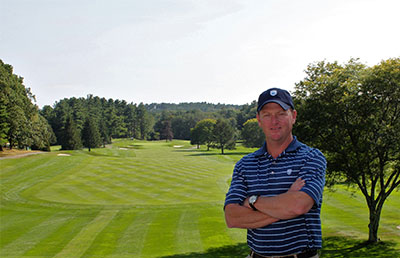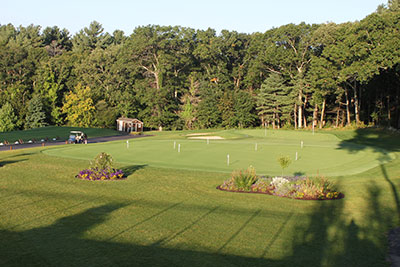Sometimes the grass is greener

Jason Adams has been a superintendent for almost 20 years. He says the “hands-off style” of the new course owner has revitalized him.
Management companies, owner/operators and superintendents have not always had the best relationships. However, my experience with a troubled course and a management company as the new owner may give some of my colleagues a chance to reconsider this type of affiliation. Here’s my story.
Blue Hill Country Club, a member-owned private country club established in 1925 just outside Boston, used to be prominent and thriving, hosting the 1956 PGA Championship and several LPGA events in the early ’90s. But like many American clubs, large capital investment projects and the downturn of the golf economy started a slow, downward financial spiral.
In 2002 and 2003 the club borrowed millions of dollars to upgrade the outdated golf course, irrigation system, member locker rooms and bar. This created some dissension, and many members left. At that time, the club also had hefty assessments on top of its already high membership dues, which kept new members from joining.
In 2008, the club experienced what other clubs in the United States already had experienced. The club dropped from 350 equity golf members to 230 equity golf members. Budgets and capital projects slowly dwindled. Its head barely above water, the club chipped away at whatever capital projects it could afford. However, the property’s infrastructure, which had been ignored for years, worsened and was now more expensive to repair. The club was dated and lacked the funding to maintain its position in the local market.
Enough is enough
In the winter of 2012, the club’s board of directors proposed hiring an third-party management company to help, and did so on Feb. 1, 2013. A new general manager was brought in, as well as a new food and beverage team. New policies and procedures were put in place, as well as new accounting programs and reporting.
Differences in the day-to-day operations were immediately noticeable. However, the facility still lacked capital funding. At a meeting with the membership during the summer of 2014, and taking the management company’s advice, the board proposed a $2.1 million renovation to the clubhouse. Department heads attended the meeting as a show of support.
The meeting quickly went bad. Members voiced concerns about the project and where funding would come from. Some members became vulgar and made verbal personal attacks on board members. The situation was extremely uncomfortable.
Over the next few months, the board held online meetings with the membership on possible “save the club” scenarios. One option was to acquire new capital from an investor. Surprisingly to the board, support was overwhelming to recapitalize or sell the club. The members said they’d had enough. They saw their beloved club struggling and wanted their once vibrant and healthy venue back and flourishing again.
After months of work, including course tours and due diligence, the board elected to sell the club to Concert Golf Partners. A new chapter was about to begin.
Full speed ahead
Fast forward to today and what Concert Golf Partners has done for the course, me and my Blue Hill Agronomy Department.
In my previous nine years of employment, greens committees, boards of directors and finance committees met tirelessly about maintenance facility issues, environmental cleanup issues, a 27-year-old underground fuel storage tank, driving range and short-game upgrades and tree removal. The capital improvement wish list went on and on. Unfortunately, most of the list continued to be postponed because of a lack of capital. If the project wasn’t going to instantly increase membership numbers, it wasn’t going to happen.

Over the last 17 months, Blue Hill has completed several projects, including the addition of a 50,000-square-foot practice facility.
Concert Golf Partners in 17 months has financed these items and more throughout the club. Completed last season was a major renovation of the driving range, with an addition of a 50,000-square-foot short-game practice facility. Two months after purchasing the club, I had conversations about the project with Peter Nanula, Concert Golf’s chairman of the board, and John Kopack, regional director of agronomy. I presented them with designs and options I had been working on. They liked what they saw and told me, “Full speed ahead!” They gave me the opportunity to design the project, manage bids and oversee the endeavor.
It was an opportunity many superintendents don’t get. There were no greens committee meetings, no board meetings or finance committee meetings. I think there were a few emails and a couple of phone calls — that’s it! Forty-six days later, the project was complete.
During the same period, we renovated the 6th hole on our other 9-hole course, completed a large environmental cleanup, installed a 1,300-square-foot fertilizer storage building, installed a new 1,200-square-foot office and breakroom facility, removed that 27-year-old underground fuel storage tank, and installed a new 1,000-gallon aboveground fuel storage tank, all within six months. Whew! It has been a fulfilling and exciting experience. Projects I dreamed about completing for years are finally being done, and I’m having a blast doing them.
Things are just as gratifying on the operations side. Buying fertilizer, chemicals and equipment has never been easier. Concert Golf has created national account programs with a great portfolio of major industry vendors. I’ve been able to create an even better agronomic program for the golf course at a significant price reduction.
Capital equipment purchases work the same way. Concert Golf gives each of its superintendents a fixed annual budget amount for constant equipment replacement. This allows me to create a long-range replacement plan without having to meet with greens committees or finance committees. Too many times in years past, capital equipment would take a back seat to other items at the club, making it difficult to execute a long-range plan.
A hands-off style
We are now into our second season with Concert Golf, and upgrades continue. Last winter we removed a few hundred trees that had been encroaching on the course, which always is a touchy subject at member-owned clubs. We also completed a fairway expansion and bunker renovation on our second green.
Again, it was as simple as an email to Mr. Nanula about the project, and we were off and running. It’s just not that easy at a private club. The project has been received with excitement from the members. They are thrilled to see great things happening to the golf course.
Change is not easy, and it is human nature to resist it. However, superintendents must deal with change daily. We always shift gears to reach goals. I’m happy I decided to stay at Blue Hill and experience what Concert Golf Partners has to offer.
The opportunity has revitalized this 19-year superintendent. The hands-off style of the company gives me a feeling of autonomy. The influx of capital has given new life to the club. We have increased our membership significantly and are almost full. Blue Hill CC once again has become a lively, vibrant and healthy club for all members to enjoy.
Photos: Andrew Farrell (1), Jason Adams (2)
Jason Adams, superintendent at Blue Hill CC, appeared on the cover of the July 2007 Golfdom when he was superintendent at Norfolk GC, in the article “Fine by Nine,” about 9-hole courses. Check out his blog at bluehillccgrounds.wordpress.com.








